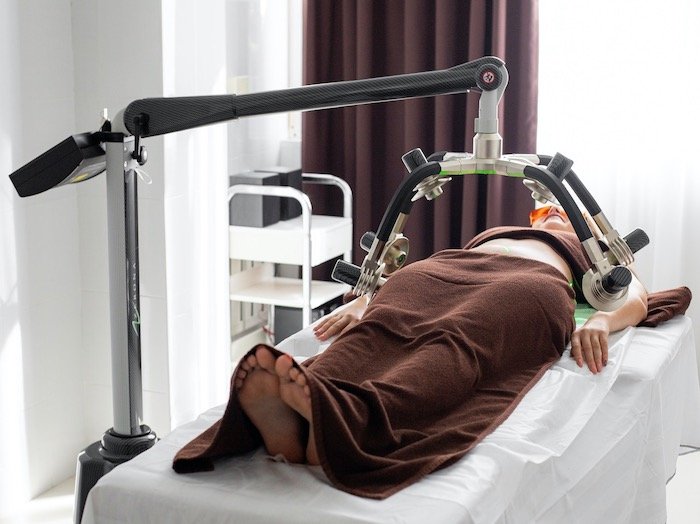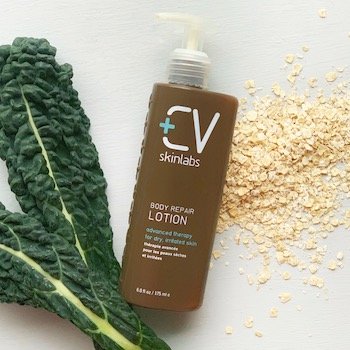
If you’re going through radiation treatment for cancer, you may be concerned about skin recovery.
Radiation treatments can be tough on the skin. They may cause redness, inflammation, and burns.
Fortunately, we’re highly knowledgeable about this side effect. Not only has our CEO, Pam Friedman, gone through cancer herself, but our products were created specifically to help those with medically treated skin.
How Does Radiation Affect Skin Recovery?
Doctors use high-energy radiation to shrink or kill cancer cells. Radiation is often part of the treatment plan for many types of cancer, including lung, breast, prostate, and lymphoma. It is usually administered from a machine outside the body via radiation beams or x-rays.
When radiation passes through the skin, the healthy cells in the treated area may be damaged. Though the skin is good at repairing itself, multiple radiation treatments given over weeks or months may challenge that repair cycle. The skin may not have the time it needs to recover, resulting in a variety of symptoms.
Possible Skin Changes from Radiation
Not everyone will experience skin-related side effects of radiation therapy, but many people will. The most common reaction is called radiation dermatitis, which includes these symptoms:
- Red rash (erythema)
- Redness
- Swelling
- Increased sensitivity to sunlight
- Burns
- Itching
- Peeling or flaking skin
- Blisters and wet, peeling skin (in more severe cases)
- Darkened areas of skin
These effects range from mild to severe, with the severity depending on how many radiation doses you receive and how frequently you receive them. The reaction is much like a sunburn, with the changes happening gradually over the course of treatment.
Fortunately, most of these effects will go away within a few weeks of completing your treatment. In some cases, the irradiated area may be slightly darker, thinner, or dryer than it was before.
Because these types of side effects can create interruptions in treatment—and because they can cause long-term changes in the skin—it’s important to manage them as best you can.
7 Tips to Improve Skin Recovery During and After Radiation
It’s important to both protect and treat your skin during and after your radiation therapy to create the best results. We suggest the following steps.
 1. Prevent further skin damage—stay out of the sun.
1. Prevent further skin damage—stay out of the sun.
The sun is enemy number one when you’re going through radiation. Your skin is tender and sensitive and will be much more vulnerable to sun damage. If you exposed the treated area to the sun during this time, you risk worsening the damage and creating lasting dark spots and even scars.
Stay out of the sun and use clothing to cover the treated area.
2. Use only the mildest of cleansers.
Just as your irradiated skin will be more vulnerable to the sun, so will it be more sensitive to chemicals and detergents. During your treatment period and for several weeks afterward, use only the gentlest of cleansers on your skin.
Wash with lukewarm water, and make sure your cleanser is a cream-based gentle formula without fragrances or sulfates. Don’t rub or scrub your skin, but lather carefully, rinse, then pat dry.
3. Apply a skin recovery toner.
Many toners are alcohol-based and dry the skin after cleansing. This is definitely not what you want while going through radiation therapy (or any other time, actually!).
We recommend our Rescue & Relief Spray. It attacks radiation damage from many fronts. First, it offers cooling relief. Next, it has anti-inflammatory ingredients that help soothe redness and inflammation. Finally, it will moisturize skin, helping to maintain that outer barrier.
You can use this spray anytime your skin needs it. It can be especially useful when your skin is tender to the touch and you don’t really want to rub on a lotion or cream. Simply spray on the soothing formula and let it go to work.
 4. Choose the best lotion for radiation treatment.
4. Choose the best lotion for radiation treatment.
When choosing a moisturizer, be extra careful. Your skin is suffering. It’s inflamed, red, and damaged. It’s trying to recover. The last thing it needs is to have to defend itself from harsh chemicals, preservatives, or fragrances.
We recommend our Calming Moisture and Body Repair Lotion. These two products were created specifically for medically treated skin. We made sure that they are 100 percent free of any irritants or toxic ingredients.
Then we included natural ingredients like Reishi mushroom and turmeric to help tame inflammation and redness.
Next, we added beta-glucan to help soothe the itch. Finally, we added natural oils to penetrate deeply into the skin and encourage moisturization and healing.
5. Help skin recovery with a healing balm.
Once you start experiencing rashes, radiation burns, or peeling and flaking skin, you’re going to need more than just a lotion to deal with it.
This is when you add a healing balm to your daily regimen. This is your extra treatment to help the skin manage the stress and better recover when the radiation is over.
We suggest our award-winning Restorative Skin Balm. Like our other products, it was designed specifically for medically treated skin. It also contains Reishi mushroom and turmeric for their productive and anti-inflammatory effects. But then we took it a step further.
This balm is made to instantly soften severely dry and chapped skin. Apply it to the red, burned area for soothing relief, then leave it on for lasting moisturization and protection. It contains carnauba and beeswax to safeguard the moisture barrier, helping to reduce dryness and flaking. It also has a powerful combination of antioxidants and fat-soluble vitamins that help encourage skin regeneration.
You will probably have to clean this off your skin before each radiation treatment, as your skin needs to be clean and dry. But applying it regularly the rest of the time may help minimize the damage and could save you from blistering.
6. Use cool compresses after each treatment to speed skin recovery.
Just as you would treat a regular burn with a cold compress, you can do the same with radiation burns. After each treatment, apply a cool compress to the treated area. This will help reduce the swelling and redness that may result.
Do be sure anything you apply to the skin is clean and free of bacteria (to reduce the risk of infection). Also, don’t use extreme cold. Ice packs are out. Instead, try cold water packs or packages of frozen veggies through a moist cloth.
Soothing hydrogel sheets and packs are also available from medical and home health suppliers. They’re sterile and hydrating and are easy to work with.
7. To inspire faster skin recovery, eat well, and stay hydrated.
While you’re feeding your skin moisture from the inside, you want to be sure you’re doing so from the inside as well. Dry, burned, parched skin needs moisture from deep in the cells. Make sure that you’re getting enough water and water-rich fruits and vegetables in your diet.
A healthy, well-balanced diet is also important to the health of the skin. Your skin is your body’s largest organ, and its health depends on the nutrients it gets from your diet. Work with your dietician if you need to to make sure you have an appropriate meal plan. Then make sure to always keep a water bottle with you and sip throughout the day.
How do you encourage skin recovery during radiation therapy?
Featured image by Dmitriy Ganin from Pexels.

